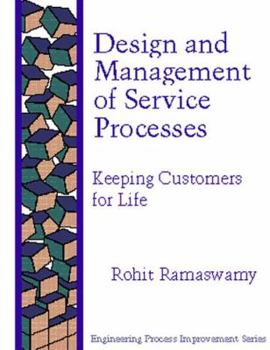Design and Management Service Processes: Keeping Customers for Life
Select Format
Select Condition 
Book Overview
PLEASE PROVIDE COURSE INFORMATION PLEASE PROVIDE This description may be from another edition of this product.
Format:Paperback
Language:English
ISBN:0201633833
ISBN13:9780201633832
Release Date:May 1996
Publisher:Prentice Hall
Length:464 Pages
Weight:0.15 lbs.
Dimensions:0.9" x 6.5" x 10.2"
Customer Reviews
5 ratings
ClassText Book
Published by Thriftbooks.com User , 17 years ago
I had to get this book for a class. Not fun reading by any means, but good for class.
Extremely useful book with the emergence of BPM
Published by Thriftbooks.com User , 22 years ago
This is a very useful book for anybody interested in designing and managing customer friendly services. The methodology that the author uses (unfortunately does not have a name) can easily be tweaked for manufacturing processes. With Business Process Management currenly gaining acceptance, this book would be a must. Specific comments include:1. Content on simulation is basic. The reader must do some additional reading outside this book to really start doing useful simulations. 2. Replace flow charting conventions with more accepted and evolving conventions like IDEF, BPMN, UML 2.0 etc. 3. Content on measuring performance is also basic. A reader must probably read some additional books on Balanced Scorecard or Dynamic Balanced Scorecard. 4. Enhance these ideas with BPO related content. Please note that most of my specific comments are developments that have happened or are happening after this book was published.
Leads the way towards effective service delivery
Published by Thriftbooks.com User , 24 years ago
This book examines service processes from both the internal and customer's viewpoints, and provides a clear path to capturing, analyzing and integrating metrics from viewpoints. If you follow the design approach that the author proposes you will have baseline processes that are measurable and manageable. More importantly, you will have a process that is flexible enough to follow changing customer requirements and demands, as well as lending itself to continuous improvementI like the comparison made early in the book between products and services and the emphasis on not only design of services, but delivery. These are reinforced by fictional case studies and examples that transform theory into practical steps.In the section devoted to actual design of service processes the author uses quality function deployment (QFD), which is a powerful technique that has proven itself repeatedly since it was first used by Japanese shipbuilders in the mid-60s. In my opinion QFD is the best technique for capturing, assessing and managing requirements. Its key strengths are the ability to quickly perform a comparative analysis on the whats and hows, show correlations and trade-offs in a quantifiable manner, and superimpose a competitive analysis. The most important aspect of QFD, though, is that it captures the voice of the customer.The author drills down into design concepts and introduces another powerful technique called the Pugh Method (named after Professor Stuart Pugh), which is a highly refined approach to evaluating design concepts and selecting the best concept from competing alternatives. While I had a great deal of experience with QFD, the Pugh Method was new to me and I have quickly added it to my collection of best practices and tools.In the section on management and improvement the real work begins. Here the author thoroughly covers design implementation. This looks easy on paper - doing it is another thing and the advice offered is on the mark. Measuring performance of the process (internal view) and assessing customer satisfaction (external view) are discussed in detail and quantitative methods are heavily employed. I thought the chapter on assessing customer satisfaction was among the best approaches I have come across. I also liked the chapter on improving service performance. This chapter shows you how to ensure continuous improvement of service delivery, which is key to staying one step ahead of customer demands.I develop and implement information technology service support and delivery processes for a living. This book has influenced my thinking over the years and the approach has been successfully implemented within that environment. However, the approach can be applied to any service, which is evidenced by the examples and case studies that are used throughout the book, none of which have anything to do with information technology. This book is the first one I recommend to colleagues, and it has my highest recommendation for an
Invaluable
Published by Thriftbooks.com User , 26 years ago
This is the only book in print today that deals specifically with service design. Dr. Ramaswamy explores this subject in great depth, providing tremendous detail and essentially opening the gates to those service companies that would like to emulate the fabled six sigma approach. Dr. Ramaswamy is a skilled communicator and academic, whose style leaves no stone unturned for any manager who is seriously interested in the subject of service design.
The definitive work on service design and improvement.
Published by Thriftbooks.com User , 27 years ago
Back in the summer of 1995, I had the pleasure of reviewing two drafts of this book prior to its publication. The book has two primary strengths. First, it provides crystal-clear explanations of sophisticated techniques in the order in which they should be used for effective design and ongoing improvement of service processes. In this sense, the book is like a textbook, but it does not contain a problem set. Second, the book provides guidance to the practitioner in an "over-your-shoulder" style that approaches what it is like to have Dr. Ramaswamy consulting for you and sharing his methodology with you. I highly commend this book to you!William J. Feuss, District Manager - Customer Value Strategy, AT & T Business Services





